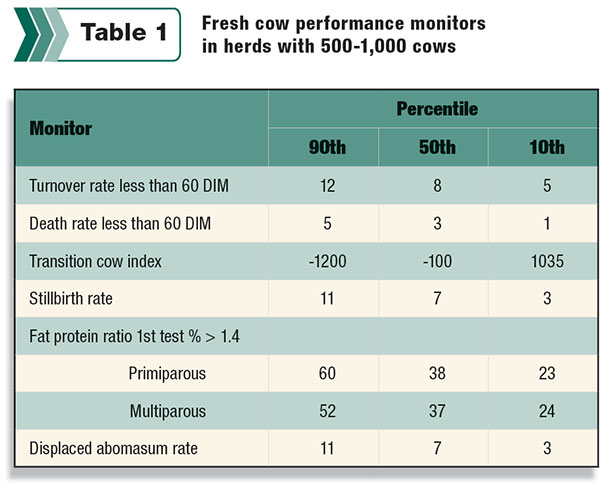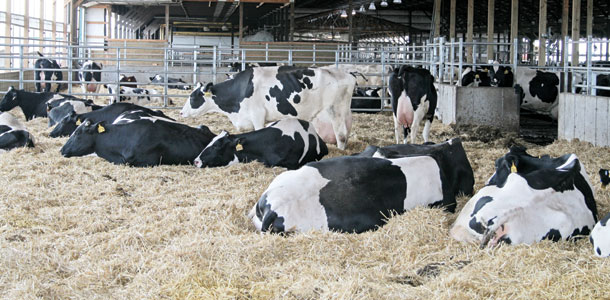“The only thing that should happen at calving time is that the cow should deliver a live, healthy calf.” All too frequently, the transition period is a tumultuous time for our dairy cows: Changes in diet, new surroundings and group changes are very challenging to cattle, who can best be described as lovers of a mundane routine.
Is it any wonder then that fresh cow health and early lactation performance is in need of improvement in our dairy industry, particularly in our larger herds?
The data shown in Table 1 is taken from AgSource Cooperative Services DHIA information for herds with 500 to 1,000 cows. The average herd in this group suffers a 7 percent displaced abomasum rate, 7 percent stillbirth rate and loses 8 percent of the cows within 60 days in milk (DIM), with 3 percent due to death.

Improvements can be made and are being made by the top herds in our industry, as can be seen by the performance of the top tenth percentile of herds.
Excellent fresh cow performance is a function of good nutrition and feeding management, committed and skilled caregivers working in the maternity area and early lactation pens and good facilities.
The latter aspect has been our focus over the last decade, with our research and clinical experiences culminating in the Dairyland Initiative Wisconsin Blueprint for the construction of improved cow facilities, which promotes cow well-being and better performance.
The Wisconsin Blueprint for transition housing lists four main characteristics for barn designs:
- 30 inches of bunk space for cows from 21 days before to 21 days after calving
- A soft bed to rest upon such as sand-bedded freestalls or a comfortable, clean dry bedded pack
- Sufficient space to rest in a well-designed stall or lying area free of competition
- Social stability and avoidance of regrouping within the last seven days before calving
The social stability aspect of these recommendations has come under some scrutiny in recent times and is worthy of further discussion.
The reasoning behind the fourth recommendation is based on our clinical experiences troubleshooting fresh cow problems with the common finding that the movement of cows into a new pen within the critical period three to seven days before calving appeared to increase the risk for ketosis, DA and other health-related problems after calving – presumably due to an interruption in dry matter intake (DMI) at this critical time.
In a study performed during the prefresh period using groups of six cows and re-grouping three cows at a time, workers in Canada were able to show that the cows moved into the new pen suffered a 9 percent decline in DMI on the day after the move, while the resident cows showed little change.
In order to avoid this potential problem, larger herds developed an approach now known as “just-in-time calving.” This is commonly practiced in the industry and involves surveying the prefresh pen hourly and moving cows at the point of calving into an individual or group calving pen. In many herds the system works well, avoiding group changes within the last week before calving.
However, it cannot be managed well in smaller herds that do not have the manpower to watch cows every hour of every day, and in some herds where workers tend to move cows too soon – in the earlier stages of labor, dystocia and stillbirth – problems emerge.
As an alternative management strategy, we created the concept of smaller, socially stable groups of cows, kept together for the entire prefresh or dry period on a series of bedded packs. Once the group was formed, no new cows were added and the pen was eventually emptied as cows calved – eliminating social stress.
A number of farms employed the approach that was put to the test at our own UW – Arlington dairy facility. In that study, groups of 10 cows were kept together for 14 to 28 days before calving in bedded packs and compared to similar groups where new cows were added twice a week. No difference in performance between the groups was identified – both were excellent.
A number of producers liked the social stability concept as it had a number of other benefits related to feeding dry cows and limiting the size of groups that had to be watched for calving activity, but they also wanted to retain the just-in-time calving approach.
This “hybrid” approach utilized stable groups of cows during the prefresh period housed in freestall pens and a separate calving area.

The approach was put to the test in a recent Minnesota study, where groups of Jersey cows were managed in stable freestall-housed groups five weeks prepartum and compared with groups in a similar environment where new cows were added once per week. Once again, no difference in performance was observed between the groups in that study.
Overall, we can summarize these experiences and findings by stating that we know there is a risk for prefresh cows to drop in DMI close to calving when they are moved into new groups. However, when we compare socially stable groups and groups with once- or twice-a-week pen additions, no significant influence on performance is identifiable – both groups perform well.
Of note in these well-designed, controlled research studies is that the environment in the control groups is also close to ideal when we look at the other three design points in the Wisconsin Blueprint.
In the Wisconsin study, the control cows had a minimum of 30 inches of bunk space and ample space to rest on a clean, dry bedded pack. In the Minnesota study, the controls were provided comfortable, deep-bedded freestalls and had a minimum of 26 inches of bunk space throughout the study.
So we believe it is important to find a way to house cows during transition to provide all four key design characteristics. We believe that avoiding pen movements three to seven days before calving is desirable, but whether or not you choose to utilize a full socially stable grouping system is a matter of choice.
Many farmers have implemented the concept in a variety of different ways in their herds and like it a lot. Others are achieving success using a well-managed just-in-time calving approach. The choice is ultimately yours. PD
Nigel Cook is currently chair of the Department of Medical Sciences at the University of Wisconsin – Madison School of Veterinary Medicine and manages the Dairyland Initiative.PHOTO
Excellent fresh cow performance is a function of good nutrition and feeding management, committed and skilled caregivers working in the maternity area and early lactation pens and good facilities. Photo by PD staff.

Nigel B. Cook
Veterinarian
University of Wisconsin – Madison
School of Veterinary Medicine






